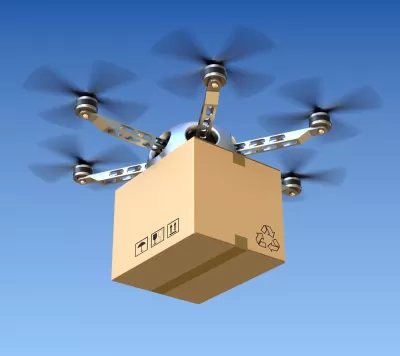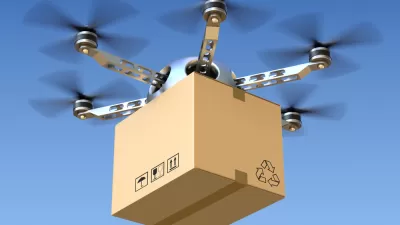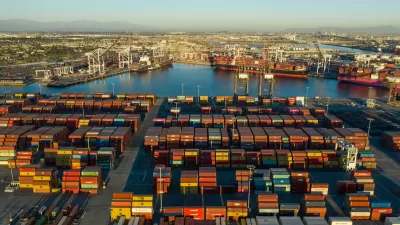Ultra-fast drone delivery promises convenience, but comes at a high cost for workers, the environment, and public space.

Drone delivery promises ultra-fast, convenient delivery of everyday goods right to your door. But there's a darker side, write Michael Richardson, Jake Goldenfein, and Thao Phan. "Drone delivery at scale will transform the skies, change expectations for speedy delivery, and hide the labour that makes it possible."
Wing, an Alphabet-owned delivery company that has made 100,000 deliveries to date in Australia, "operates much like many app delivery platforms. After signing up, customers use the smartphone app to place their orders. Orders are then packed at local base stations and flown to their destinations by Wing’s drones." But questions remain about how the service would operate in more complicated environments than the "clear and uncomplicated airspace" and "flat, regular urban environment" of its test sites, Canberra and Logan. Additionally, "automated" tech obscures the hidden human cost.
In the same way that Amazon's private delivery services created higher demand for ultra-fast package delivery, the "unbelievably fast" delivery times promised by Wing shifts customer expectations for other delivery services. "While Wing’s drones are autonomous, the service still relies on human labour. Pilots monitor flight paths, packers parcel up the products, and maintenance staff take care of the hardware and software. All of these workers must perform to satisfy the 10 minute delivery time." These "punishing delivery times," the authors argue, "can be dangerous for worker safety and devastating for morale."
In addition to the harm caused to workers, "drone delivery may also have hidden environmental costs:" lithium mining for batteries, energy consumption for data centers, more packaging and waste, and potential risks to birds and habitats. Moreover, "[d]rone delivery risks privatising a new layer of that common space, and handing it over to Alphabet and others." Australia–and other countries–would have to change their regulations regarding drones and create new digital infrastructures, a step that Alphabet is heavily involved in. "While city skies crowded with delivery drones might be far away, the groundwork is being laid right now. Communities, businesses and workers need to be a much bigger part of the process of deciding if they want that future."
FULL STORY: Privatising the sky: drone delivery promises comfort and speed, but at a cost to workers and communities

Study: Maui’s Plan to Convert Vacation Rentals to Long-Term Housing Could Cause Nearly $1 Billion Economic Loss
The plan would reduce visitor accommodation by 25,% resulting in 1,900 jobs lost.

North Texas Transit Leaders Tout Benefits of TOD for Growing Region
At a summit focused on transit-oriented development, policymakers discussed how North Texas’ expanded light rail system can serve as a tool for economic growth.

Why Should We Subsidize Public Transportation?
Many public transit agencies face financial stress due to rising costs, declining fare revenue, and declining subsidies. Transit advocates must provide a strong business case for increasing public transit funding.

How to Make US Trains Faster
Changes to boarding platforms and a switch to electric trains could improve U.S. passenger rail service without the added cost of high-speed rail.

Columbia’s Revitalized ‘Loop’ Is a Hub for Local Entrepreneurs
A focus on small businesses is helping a commercial corridor in Columbia, Missouri thrive.

Invasive Insect Threatens Minnesota’s Ash Forests
The Emerald Ash Borer is a rapidly spreading invasive pest threatening Minnesota’s ash trees, and homeowners are encouraged to plant diverse replacement species, avoid moving ash firewood, and monitor for signs of infestation.
Urban Design for Planners 1: Software Tools
This six-course series explores essential urban design concepts using open source software and equips planners with the tools they need to participate fully in the urban design process.
Planning for Universal Design
Learn the tools for implementing Universal Design in planning regulations.
Ascent Environmental
Borough of Carlisle
Institute for Housing and Urban Development Studies (IHS)
City of Grandview
Harvard GSD Executive Education
Toledo-Lucas County Plan Commissions
Salt Lake City
NYU Wagner Graduate School of Public Service





























